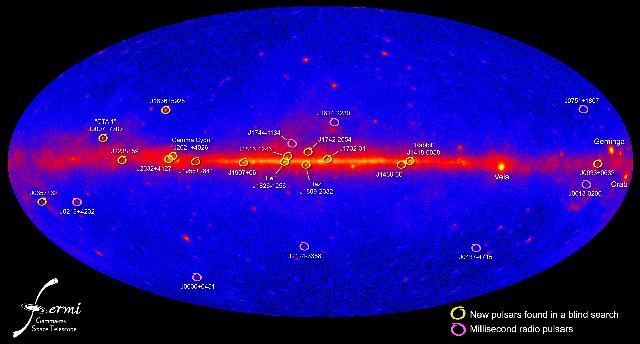
Pulsars are known to be neutron stars, remnants of the explosion of a big star, with an original mass ten times that of the Sun. Combined with their rapid spin (up to 800 rotations in a second !), their strong magnetic field ( 1013 gauss) accelerates charged particules from the star surface, or from some outer gaps in the high magnetosphere, and produces two beams of light sweeping space like the lens of a light-house. The geometry of this emission is complex and its mechanism not well known yet. We know today about 1800 radio pulsars. A few month ago, only six of these sources had been detected at very high energy, in the GeV domain, by the EGRET instrument of the Compton Gamma Ray Observatory, operating in the late 90’s. The Large Area Telescope (LAT), on board of the Fermi satellite is now scanning the gamma-ray sky since mid August 2008, after a successfull launched on June 11th. In a few month only, thanks to its higher sensitivity, tens of gamma-ray pulsars were discovered, out of which a third was totally unknown in any other wavelength domains. The bulk of these new detections is the direct outcome of the accompanying multiwavelength and timing campaign, in big majority led in radio wavelength, but also in the X-rays for some of the targets [1]. This observation campaign has required the common effort of pulsar teams attached to the largest radio dishes in the world : Jodrell Bank (Manchester, UK) and NRT (Nançay, FR) for Europe, the ATNF (Parkes, AU) for the Southern hemisphere, GBT (Green Bank, US) and CSIRO (Arecibo, US) for North America. The X-ray counterpart was conducted with RXTE and XMM-Newton satellites. The Nançay Radio Telescope has played its card right, since it is presently used to follow with a great regularity, almost half of the best gamma-ray candidates for Fermi, i.e. more than a hundred of indentified targets. Its specialization in the timing of particularly fast rotators (millisecond pulsars) was a major advantage in this campaign.
Radio follow-up and ephemerides production are essential. First of all, by monitoring the faintest variations in the pulsar rotation, they allow us to fold the rare up comming gamma-ray photons at the right rotational phase and to reveal the pulsation of the source when it exists (only one photon captured by the LAT in 500 rotations of the Crab, one of the most gamma-ray powerfull pulsar !). Moreover, by comparing the absolute phase of the signal obtained in radio waves, X-rays and gamma-rays, and by analysing the radiation beam shape and the radiation power received as a function of wavelength, one may understand and disentangle the physical mechanisms involved in the emission processes. Several models and scenarios have coexisted until now, for explaining this tremendous emission : the so-called « polar cap » models, where photons are emitted in cascades by charged particles pulled out from the surface, next to the star pole, and the « outer gap » or « slot gap models », where the gamma-ray emission is produced at higher altitude, close to the light cylinder (outer region where magnetic field lines are broken by the star rotation, which reaches the speed of the light).

Millisecond pulsars (MSP’s) form a peculiar class of objects, with extremely short spin periods down to only one or two milliseconds per turn, a weak magnetic field (108 à 109 gauss still !), and an energy loss (breaking) relatively low. They account for less than 10% of the whole known pulsar population. It is widely accepted now that they are old recycled pulsars that have been re-accelerated, by grabing matter and angular momentum to a close and less evolved companion star within a binary system. Apart from a few rare cases, it was thought that for MSP’s, the available energy to cause and supply high energy radiation would have been below the threshold predicted by emission models and then that they would not be detected at all. It turned out that, with 8 millisecond pulsars firmly detected, Fermi is bringing to light a whole population of gamma-ray pulsars among those milliseconds ones [2]. Moreover, as for the two other categories of pulsars detected, the so-called « normal » population made of young pulsars observed in radio (more than 20 objetcts), or those that are only seen in gamma-rays (16 objects, [3]), MSP’s favour models where the high energy emission takes place at high altitude in their outer magnetosphere [4, 5 and 6].
As expected, Fermi provides us for the first time with enough statistics for understanding and constraining the emission processes in action in those strange neutron stars. More surprisingly, one is discovering that pulsars are associated with, or at the origin of, the most violent phenomena in our Galaxy, and that they thus play probably an essential role in the energy equilibrium and the secular evolution of the Milky Way.
The Fermi french team for pulsar studies is composed of : At CENBG (Bordeaux) : David Smith, Denis Dumora, Lucas Guillemot, Damien Parent, et Thierry Reposeur At CEA (Saclay) : Isabelle Grenier, Marco Pierbattista At NRT (Obs de Paris et LPC2E-Orléans) : Ismaë l Cognard, Gregory Desvignes, Gilles Theureau At CESR : Nathalie Webb
References
- [1] Pulsar timing for the Fermi gamma-ray space telescope. Smith et al. 2008, A&A 492, 923 [2] A population of Gamma-Ray Millisecond Pulsars seen with the Fermi Large Area Telescope. Science, July 2009 [3] Detection of 16 Gamma-Ray Pulsars through blind frequency searches using the Fermi Large Area Telescope. Science, July 2009 [4] Pulsed Gamma-rays from the millisecond pulsar J0030+0451 with the Fermi Large Area Telescope. 2009, ApJ 699, 1171 [5] Discovery of Pulsations from the Pulsar J0205+6449 in SNR 3C 58 with the Fermi Gamma-Ray Space Telescope. 2009, ApJ 699, L102 [6] Pulsed Gamma-rays from PSR J2021+3651 with the Fermi Large Area Telescope , ApJ in press
